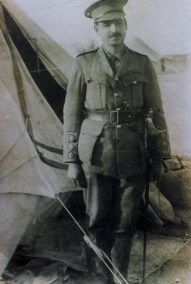><<><><>
Remembering Them in Our Street Names – FRANDI STREET
***********************************************************************************
At 5.45pm on Friday 8th May 2015, the 100th anniversary of Ateo Frandi’s death at Gallipoli, a small ceremony to unveil a sign commemorating Captain Frandi was held at Frandi Street, Thorndon in Wellington, New Zealand.
Frandi Street in Thorndon is a quiet little residential cul de sac, once known as Grant Road North, and then briefly as High Street. On 14 June 1917 Wellington City Council confirmed a change of name to Frandi Street.
><<><><><>
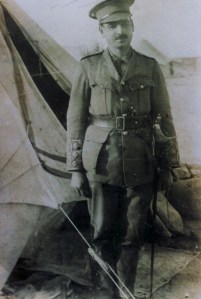
Ateo Giusto Leale Frandi 1873 – 1915
<><><><><><>
Frandi Street is named after Captain Ateo Giusto Leale Frandi, of the Wellington Infantry Battalion, who was killed at the second battle of Krithia. There are several versions of his death at the ’Daisy Patch’, either by machine gun fire or a sniper. Occasional references say he was killed on May 6th but the clear consensus is the 8th of May 1915.
With stalemate in the ANZAC area, ANZAC commander General Birdwood had sent Australian and New Zealand troops to support British, French and Indian troops attempting to capture the village of Krithia which lay between the ANZAC landing beaches and the British and French landings near Cape Helles at the southern end of the Gallipoli peninsula. Repeated attacks across open ground under heavy machine gun and rifle fire achieved temporary gains of barely a few hundred metres of ground and cost some 6300 Allied killed or wounded including 835 New Zealanders over just 4 days. Most of the dead including Captain Frandi were never identified, and were buried near where they died. After the war bodies were re-interred at nearby Twelve Tree Copse cemetery. One hundred and seventy-nine New Zealanders including Captain Frandi are commemorated there on the New Zealand memorial.
Ateo Frandi was born in Pisa, Italy on May 4th 1873, the second son of Annunziata and Aristodemo, emigrating from Italy with his parents and two siblings to New Zealand in 1876. At the time of enlisting he was single, a piano tuner by trade, and was registered as living at 16 Murphy Street, Wellington. He had also worked for the DIC department store, and was an active member of the Garibaldi Club. See post re Frandi family’s arrival in New Zealand in 1876 OKURU SETTLEMENT
Captain Frandi had spent 24 years in the volunteers and territorials in Wellington, and for many years commanded the 31 Company (Wellington) Senior Cadets. He was rated as ‘one of the first authorities in infantry drill in New Zealand.’ His YMCA Cadets had won the New Zealand competitions for two years straight.
How Ateo Frandi’s lost Long Service medal was re-discovered: https://frandi.wordpress.com/2020/04/23/blog-comments-ateo-frandi-zealandia-rifles-1911-lost-long-service-medal/
In 1912 a dispute between Captain Frandi and the Defence Department over seniority between Captain Frandi and another officer was widely reported throughout the country and even referred to in Parliament on a number of occasions. Captain Frandi originally resigned over the dispute, but retracted his resignation and was able to resume his command of the Cadets.
Wellington was the embarkation port for some 60% of our soldiers, and Captain Frandi’s unit embarked for Egypt on 14 December 1914 with the Second Reinforcements. He arrived in Suez on 28 January 1915 and landed at ANZAC Cove on April 25th.
Major-General Godley, commanding the New Zealand Expeditionary Force at Gallipoli wrote, reporting Captain Frandi’s death – published in the Evening Post, “He did so much good service in Wellington that it should be known how well he did on active service” and “His company all say that they have never known any officer who gained so rapidly the confidence and liking of the men under him, and his bravery and fearlessness and qualities of leadership were most conspicuous.”
All the Frandi brothers enlisted; Lance Corporal Antonio Raffaello Frandi served in the 1st NZRB B Company, Driver. Alfredo Giusseppe Frandi (Anne Frandi-Coory’s grandfather and youngest brother of Ateo) and nephew, Driver Ricciotti (Richard) Frandi, were both in the Main Body Field Artillery. Nephew, Gunner William Donald Frandi, was in the 7th Field Artillery, and nephew Menotte Frandi also served. Nephew William Frandi, a gunner with the Field Artillery was reported wounded in the Evening Post of 27 September 1916 which said three others of the family were also serving at that point.
><><><><>
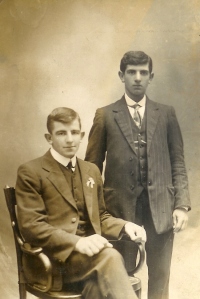
Ateo’s nephews Ricciotti and William Frandi
><><><><>
Ateo’s Will named as first beneficiary his sister Italia Corich and her daughters Helena and Elvira. The Pension Board granted his parents support in November 1915 on receiving confirmation that he had financially supported them. His father Aristodemo died aged 86 in 1919, and mother Annunziata aged 79 in 1920.
Captain Frandi was clearly held in high esteem. A concert in his memory was held by the Senior Cadets on the first of November 1915 in the Wellington Town Hall.
When the Carillon was built as a memorial to those who had served in the War, most of its 49 bells were named for specific battles, and in memory of individual soldiers. Captain Frandi’s sister, Italia, paid for bell number 30, ‘Krithia’, in his memory. His mother donated a memorial shield for the Cadets, now held at the Army Museum in Waiouru.
I saw Captain Frandi’s name on one of the white crosses of remembrance at each of several local school and community commemorations recently. At ANZAC commemorations we say ‘At the going down of the sun and in the morning, we will remember them.’ This Friday 8th as the sun goes down at 5.45, we will remember one of those men, as was intended when the Council of 1917 renamed a little street in Thorndon.
This post is taken from an article specially written by Wellington City Councillor, Andy Foster, for the commemoration of Frandi Street.
Photographs by Neil Price.
><><><><><><
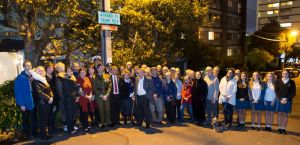
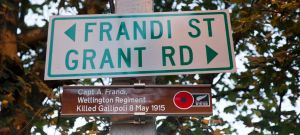
><><

Bugler, Andrew Weir, plays The Last Post

Left to right: Paul Glennie WCC, Andy Foster WCC, Italian Ambassador His Excellency Carmelo Barbarello, Captain Paul Prouse Officer Commanding Wellington Company 5/7 Battalion RNZ Infantry Regiment, Sub Lieutenant Sean Audain (HMNZS Olphert)

The Last Post following Andy Foster’s reading of the dedication to Ateo Frandi.
><><><><><><><><

Wellington City Councillor Andy Foster reads a statement by Anne Frandi-Coory on behalf of descendants of Ateo’s parents, Annunziata and Aristodemo Frandi.
On behalf of all descendants of Aristodemo and Annunziata Frandi, I would like to thank Andy Foster along with Wellington City Council for this commemoration to Ateo Frandi for his long and dedicated service to the New Zealand Armed Forces. Ateo was greatly influenced by his father, Aristodemo, in fighting for a country he loved. Aristodemo was a brave fighter in Italy’s struggle to free itself from foreign rulers, before he and Annunziata emigrated to New Zealand in 1876. Ateo in his turn was so proud to be a part of the ANZAC contingent to Gallipoli, and he urged his brothers and nephews to join up as a duty owed to their country. Ateo Giusto Leale Frandi, we will never forget you or the ultimate sacrifice you made. —- Anne Frandi-Coory
